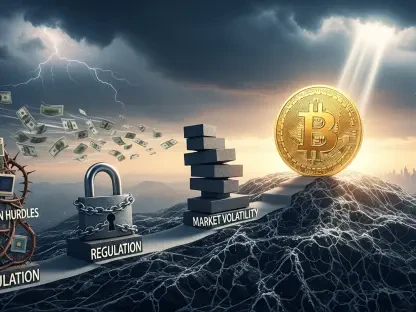In a world where financial stability hangs by a thread, the recent U.S. government shutdown has laid bare the vulnerabilities of centralized systems, exposing cracks that run deeper than mere political deadlock, while delayed payments, market volatility, and institutional inefficiencies have shaken public trust, creating fertile ground for alternative solutions to emerge. Amid this turmoil, PiUSD, a treasury-issued digital unit within the Pi Network ecosystem, steps into the spotlight as a potential disruptor. Unlike fleeting cryptocurrency trends, this decentralized instrument promises a reimagined approach to money, one rooted in stability and community trust. As traditional finance falters under the weight of its own flaws, the stage is set for a bold contender to challenge long-standing paradigms. The question looms large: can a system built on ethical principles and decentralized governance offer the resilience that legacy structures so desperately lack? This exploration delves into PiUSD’s potential to reshape the financial landscape.
The Roots of Financial Instability
Unveiling Systemic Weaknesses
The U.S. government shutdown stands as a glaring indictment of centralized financial systems, revealing profound inefficiencies in budget oversight and institutional dependability. Far from being a minor hiccup, this event has disrupted essential services, delayed critical payments, and injected uncertainty into global markets. Such breakdowns highlight a broader fragility, where reliance on centralized mechanisms leaves economies vulnerable to political gridlock and administrative failures. Public confidence, already strained, erodes further as these systemic flaws come to light. It’s within this context of instability that alternative financial models gain traction, offering a chance to address the shortcomings of traditional structures. PiUSD, with its decentralized framework, emerges as a response to these challenges, positioning itself as a viable option for those disillusioned with the status quo. The shutdown, in essence, acts as a stress test, exposing the urgent need for innovation in a landscape riddled with outdated practices.
This moment of crisis also underscores the cascading effects of centralized fragility on everyday life, from stalled government programs to jittery financial markets. Beyond the immediate disruptions, the shutdown reveals a deeper inability of legacy systems to adapt to modern economic demands. Budget mismanagement and bureaucratic inertia amplify the fallout, leaving individuals and businesses grappling with uncertainty. This environment of distrust creates a unique window for decentralized alternatives to prove their worth. PiUSD, built on principles of transparency and community engagement, offers a contrast to the opaque and often exclusionary nature of traditional finance. By stepping into this gap, it challenges the notion that centralized control is the only path forward. The weaknesses unveiled by such systemic failures pave the way for a broader conversation about what finance could become if reimagined from the ground up, free from the constraints of entrenched inefficiencies.
The Call for a Financial Reset
The systemic issues exposed by recent events are not mere temporary setbacks but symptoms of structural flaws that demand a fundamental overhaul of financial systems. Centralized models, often tethered to debt-driven currencies and speculative practices, struggle to meet the needs of a rapidly evolving global economy. This persistent instability signals a critical juncture where clinging to outdated frameworks risks further erosion of trust and functionality. PiUSD presents itself as a beacon of change, advocating for a shift away from the volatility of fiat and speculative digital assets toward a model grounded in verifiable contribution and collective trust. Such an approach challenges the very bedrock of traditional finance, proposing a system where value is tied to real utility rather than abstract speculation. The urgency for this reset grows as each crisis reveals the limitations of legacy structures.
Moreover, the call for a financial reset extends beyond fixing immediate problems to envisioning a more equitable and resilient framework for the future. PiUSD’s emphasis on decentralization offers a pathway to redistribute economic influence, moving away from the concentrated power of banks and financial elites. This isn’t merely about replacing one currency with another but about rethinking the principles that underpin money itself. By prioritizing ethical alignment and community involvement, PiUSD seeks to address the exclusionary tendencies of current systems, where access to financial tools often remains limited to a privileged few. As centralized systems continue to falter under pressure, the push for a reset becomes not just a reaction to failure but a proactive step toward building something inherently stronger. This shift invites a broader dialogue on how financial systems can better serve society as a whole, rather than perpetuating cycles of instability and inequality.
PiUSD: A New Financial Instrument
Core Design and Principles
At the heart of PiUSD lies a design philosophy that sets it apart from both traditional fiat currencies and the often volatile world of cryptocurrencies. Built on the principles of stability through verified user participation, this digital unit leverages blockchain technology to ensure transparency at every level of interaction. Its mobile-first accessibility broadens its reach, making financial tools available to those traditionally excluded from banking systems. Beyond technical features, PiUSD aligns with ethical community values, positioning itself as a currency that prioritizes inclusivity over profit for a select few. This focus on contribution-based value—where economic worth is tied to tangible utility—offers a stark contrast to debt-laden fiat systems or speculative digital coins. In an era marked by financial uncertainty, PiUSD’s core design seeks to establish a more predictable and trustworthy alternative, addressing the root causes of distrust in existing monetary frameworks.
Equally significant is how PiUSD redefines the concept of financial participation through its community-centric approach. Unlike centralized currencies controlled by governments or banks, this digital unit empowers users to play an active role in its ecosystem, fostering a sense of ownership and accountability. Transparency isn’t just a buzzword here; it’s embedded in every transaction through immutable blockchain records, ensuring that users can verify the integrity of the system. Accessibility, too, is a cornerstone, with infrastructure designed to function seamlessly on mobile devices, reaching populations in underserved regions. This ethical grounding—where the system serves the collective rather than elite interests—marks PiUSD as a movement toward inclusive finance. As traditional systems grapple with opacity and exclusion, PiUSD’s principles offer a blueprint for a financial landscape that values fairness and resilience above all, challenging long-held assumptions about how money should work.
Integration with Pi Network Ecosystem
PiUSD’s strength is amplified by its deep integration into the Pi Network ecosystem, a robust framework tailored for decentralized commerce and governance. This environment includes essential tools like the Pi Wallet for secure storage, the Pi Browser for seamless interactions, and smart contract layers that automate and safeguard transactions. Additionally, KYC protocols ensure user verification, adding a layer of trust and security to the system. Together, these components create a cohesive platform where PiUSD functions not merely as a currency but as the backbone of a broader economic network. This infrastructure allows for scalable applications, from peer-to-peer transfers to community-led initiatives, even in times of economic upheaval. The synergy between PiUSD and the Pi Network positions it as a practical solution for those seeking alternatives to faltering traditional systems, offering reliability where centralized models often fall short.
Furthermore, the Pi Network’s design prioritizes adaptability, ensuring that PiUSD can evolve alongside emerging financial needs and technological advancements. The ecosystem supports a range of use cases, from everyday transactions to complex decentralized applications, making it a versatile tool for users worldwide. Security remains paramount, with layered protocols protecting against fraud and unauthorized access, while smart contracts reduce the need for intermediaries, cutting costs and increasing efficiency. This integration also fosters community-driven development, where users can propose and implement changes, reinforcing the democratic ethos at the system’s core. In contrast to rigid legacy systems that struggle to innovate under pressure, PiUSD’s embedding within the Pi Network offers a dynamic foundation. This adaptability could prove critical as global finance faces ongoing uncertainty, providing a stable and forward-thinking alternative for transactions and governance alike.
Challenging the Old Guard
Redistributing Financial Power
PiUSD represents a direct challenge to the long-standing dominance of Wall Street and speculative finance by shifting economic influence toward decentralized communities. This isn’t merely about creating another currency but about fundamentally altering how financial power is distributed. By prioritizing utility and contribution over short-term speculative gains, PiUSD seeks to dismantle the profit-driven hierarchies that have defined traditional markets for decades. This redistribution empowers individuals and smaller collectives, giving them access to tools and opportunities often reserved for financial elites. The focus on sustainability over fleeting profits marks a radical departure from the boom-and-bust cycles perpetuated by centralized systems. As a result, PiUSD aims to create a financial environment where economic incentives align with long-term societal benefits, challenging the very structures that have concentrated wealth and influence in the hands of a few.
Additionally, this shift toward decentralization through PiUSD carries the potential to redefine economic equity on a global scale. Traditional financial systems often exclude vast populations from meaningful participation, whether due to geographic barriers or socioeconomic constraints. By contrast, PiUSD’s model encourages inclusivity, allowing users from diverse backgrounds to engage in a system that values their input and rewards their involvement. This isn’t just a reaction to the failures of Wall Street but a deliberate strategy to build a more balanced economic landscape. The emphasis on community-driven finance disrupts the notion that financial power must reside in centralized hubs, proposing instead a network where influence is shared. Such a transformation, while ambitious, addresses the growing demand for fairness in finance, offering a glimpse of a system where prosperity isn’t dictated by a handful of institutions but cultivated through collective effort and shared goals.
Overcoming Entrenched Interests
While the vision behind PiUSD inspires hope for a more democratic financial future, the path to realizing this change is fraught with obstacles posed by entrenched interests. Centralized powers, including legacy banks and financial giants, have long benefited from the status quo, wielding significant influence over policy and market dynamics. Their resistance to decentralization is not merely passive; it often manifests as active opposition through regulatory hurdles or lobbying efforts to maintain control. PiUSD’s push for a redistributed economic order must navigate this complex landscape, where systemic inertia acts as a formidable barrier. The challenge lies in dismantling decades of established norms without triggering destabilizing backlash from those who stand to lose their grip on power. Balancing this delicate transition requires strategic foresight to ensure that the benefits of decentralization outweigh the friction of reform.
Beyond the resistance of financial titans, PiUSD also faces the hurdle of public perception shaped by years of reliance on traditional systems. Convincing individuals and businesses to adopt a decentralized model involves overcoming skepticism and ingrained habits tied to familiar banking structures. Many may view alternatives like PiUSD with caution, associating digital currencies with volatility or fraud due to past cryptocurrency missteps. Addressing these concerns demands not only robust technology but also comprehensive education to highlight the stability and ethical grounding of this new approach. The road ahead requires patience and persistence, as changing entrenched mindsets takes time even in the face of evident systemic failures. PiUSD’s journey to redefine finance hinges on navigating these cultural and institutional challenges, proving that a decentralized future isn’t just possible but preferable in a world weary of centralized shortcomings.
Building a Decentralized Future
Community Engagement as the Key
The success of PiUSD hinges on the active participation of a diverse user base, including pioneers, merchants, and developers who see its potential to transform everyday transactions. Adoption isn’t a passive process; it requires individuals to embrace PiUSD for real-world applications, from small-scale purchases to larger economic exchanges. This grassroots involvement is critical, as the currency’s value and utility grow with each user who integrates it into their financial practices. Beyond mere usage, community members play a vital role in governance, contributing ideas and feedback to shape the system’s evolution. Educating others about the benefits of contribution-based finance further amplifies PiUSD’s reach, building a network of advocates who champion its principles. In a landscape where centralized systems often alienate users, this collective effort stands as the linchpin for creating a financial model that truly serves the many rather than the few.
Moreover, community engagement extends to fostering a culture of trust and collaboration, essential for PiUSD to thrive amid widespread financial disillusionment. Developers, for instance, are tasked with innovating within the ecosystem, crafting applications that enhance functionality and user experience. Merchants adopting PiUSD for transactions signal its practical worth, encouraging wider acceptance across markets. Pioneers, meanwhile, act as ambassadors, spreading awareness and demonstrating the system’s reliability through their own participation. This multifaceted involvement creates a self-reinforcing cycle where each contribution strengthens the network’s foundation. Unlike top-down financial models that dictate terms to users, PiUSD’s growth depends on a bottom-up approach, where every stakeholder has a stake in its success. This dynamic positions community engagement not just as a strategy but as the very essence of building a decentralized financial future.
Vision for a New Monetary Order
Looking ahead, PiUSD holds the promise of reshaping global finance through integration into decentralized commerce and cross-border payment systems. Envision a scenario where this digital unit gains formal recognition as a treasury-backed asset, offering stability in regions plagued by currency volatility. Its potential to streamline international transactions could reduce reliance on cumbersome, fee-heavy banking networks, making financial interactions more efficient and accessible. Additionally, PiUSD might inspire innovative governance models for monetary policy, where community input directly influences economic decisions. While uncertainties and resistance from traditional powers persist, the groundwork laid by its design and ecosystem suggests a profound shift in how money is perceived and managed. This vision points to a future where financial systems prioritize transparency and inclusivity, addressing long-standing inequities in global economics.
Equally compelling is the possibility that PiUSD could serve as a catalyst for broader systemic change, influencing how societies structure economic interactions over the coming years. By establishing a precedent for contribution-based value, it challenges the debt and speculation that dominate current models, potentially paving the way for other decentralized initiatives to flourish. Integration with emerging technologies could further enhance its utility, enabling seamless connections across diverse financial platforms. The road to such a monetary order isn’t without challenges, as scaling to global relevance requires navigating regulatory landscapes and cultural differences. Yet, the underlying ethos of PiUSD—building finance for the collective good—offers a compelling blueprint for what’s possible. As systemic fragility continues to undermine trust in traditional systems, this vision of a new monetary framework stands as a bold response, inviting exploration of a future where money serves as a tool for empowerment rather than exclusion.









